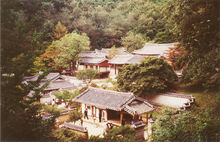| UNESCO World Heritage Site | |
|---|---|
 | |
| Location | South Korea |
| Part of | Seowon, Korean Neo-Confucian Academies |
| Criteria | Cultural: (iii) |
| Reference | 1498-004 |
| Inscription | 2019 (43rd Session) |
| Area | 36.73 ha (90.8 acres) |
| Buffer zone | 166.84 ha (412.3 acres) |
| Coordinates | 36°43′38″N 128°50′36″E / 36.72722°N 128.84333°E |
| Korean name | |
| Hangul | 도산서원 |
| Hanja | 陶山書院 |
| Revised Romanization | Dosan seowon |
| McCune–Reischauer | Tosan sŏwŏn |
Dosan Seowon (Korean: 도산서원; alternatively, Tosansowon) was established in 1574 in what is present day Andong, South Korea, in memory of and four years after the death of Korean Confucian scholar Yi Hwang by some of his disciples and other Korean Confucian authorities. Yi Hwang had retired to the location in 1549 and begun construction on the facility, a private Korean Confucian academy offering instruction in the classics and honouring the sages with regular memorial rites.
Like other Korean Confucian academies, Dosan Seowon serves two purposes: education and commemoration. The site was well known in Korea as one of the leading academies and was home to the Toegye School of Thought for over 400 years. Although the educational function of the facility has long since ceased, the commemorative ceremonies have been and are still held twice a year.
The ancient academy received a royal charter in 1575 by King Seonjo and was featured on the reverse of the South Korean 1,000 won bill from 1975 to 2007 (BOK Series Designation Series II (나) 1983–2002).
